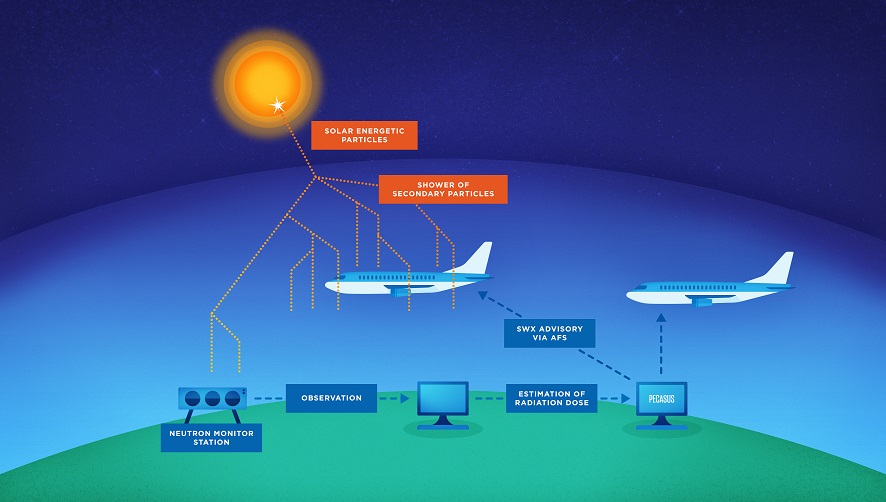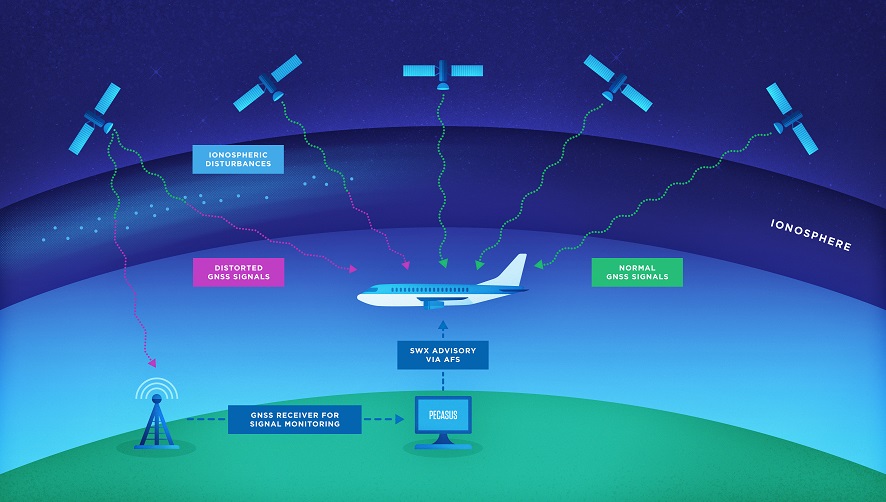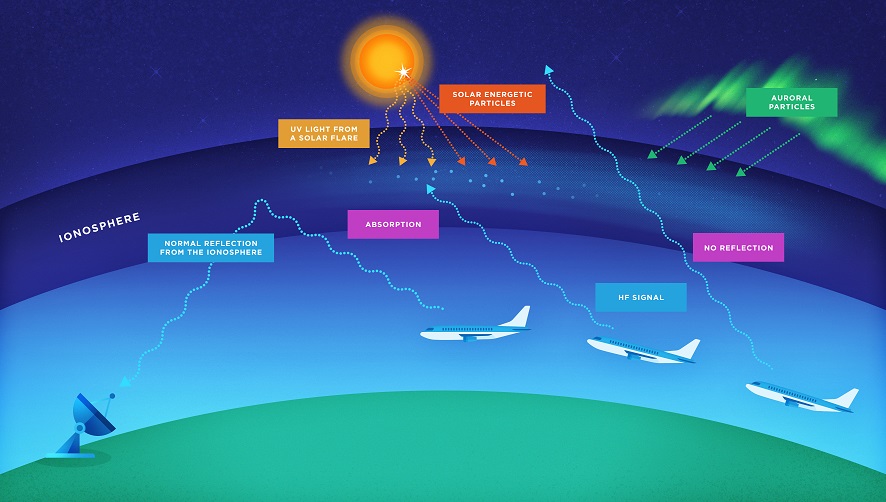By PECASUS - Partnership for Excellence in Civil Aviation Space weather User Services
Impact of Space Weather on Aviation
The Sun drives our planet’s weather and climate patterns. The exposure of regions on Earth to sunlight is a key component in weather & climate, and changes on a daily and seasonal basis. Solar energy is pumped into our atmosphere and drives the weather, potentially causing storms.
Similar to this, we have space weather and space climate. Besides sunlight entering our atmosphere, there is also solar mass continuously flowing along the magnetic shield surrounding Earth. Our atmosphere and magnetosphere can respond in a dramatic way to an abrupt change in the continuous emittance of light and mass from the Sun. A solar storm initiates space weather processes which impact our navigation and radio communication systems and can cause an increase of radiation levels at flight altitude.

Left: an intense light flash on the solar disk, SDO/AIA - Middle: a plasma cloud ejected by the Sun seen in the coronagraph LASCO C3 onboard of SOHO. The cloud perturbs the solar wind. A coronagraph makes artificial eclipses. The Sun is behind the occulter and illustrated by the white circle. - Right: solar energetic particles blind the detector LASCO C2. The white dots are particles that hit the camera.
Space Weather Warnings for Aviation
PECASUS advises pilots in case Space Weather (SWX) causes a moderate or severe impact on the radiation at flight level, Satellite navigation or long distance Radio communication.
PECASUS continuously monitors and measures the atmospheric and magnetospheric space weather parameters. When there is an indication that the health of passengers and crew might be affected due to radiation, or when the HF communication or satellite navigation is impacted, an advisory message is sent out through the standard communication networks defined by the International Civil Aviation Organization (ICAO). The advisories have a standard format.
Radiation at flight level
During solar storms, solar particles like protons can suddenly be accelerated, heading into space at great speed. When they arrive at Earth, these energetic particles can penetrate the atmosphere at the magnetic poles. They bombard atmospheric particles and create a shower of particles possibly reaching the Earth’s surface. When this happens, crew and passengers onboard airplanes are more vulnerable to this harmful radiation. The effect is stronger at high altitudes and latitudes.
SWX ADVISORY: RADIATION MOD; RADIATION SEV
Sent when the parameter ‘Effective dose at flight level’ crosses the MOD or SEV threshold

Neutron monitors are detectors on the Earth surface that measure Galactic Cosmic Rays (GCR). This is the background radiation from outside the heliosphere. The variation of GCR is negligible when it comes to human health. During a strong Solar Radiation Storm, energetic particles bombard our atmosphere and create secondary particles that are ‘seen’ by neutron monitors. When more than 3 stations measure an increase in radiation, we determine it as a Ground Level Event which also implies an extra dose of radiation on airplanes in flight. The impact depends on altitude and latitude: the higher the altitude and/or latitude, the stronger the impact.
Satellite navigation
The ionosphere plays also a crucial role in satellite navigation. The signal sent by the satellite has to pass through the ionosphere to reach the receiver. Solar storms can introduce small scale structures in the ionosphere. When the signal encounters these obstacles, its amplitude and phase can alter very rapidly. Similarly, when the number of electrons in the ionosphere increases dramatically due to a solar storm, positioning errors are introduced in satellite navigation.
SWX ADVISORY: GNSS MOD; GNSS SEV
Sent when one of the parameters ‘Amplitude scintillation’, ‘Phase scintillation’, ‘Vertical TEC (Total Electron Content)’ crosses the MOD or SEV threshold.

Solar wind disturbances and solar flares can create structures of tens of meters to tens of kms in the ionosphere. These structures form obstacles for the satellite signals that pass through the ionosphere. A radio wave can undergo rapid modification in its amplitude or phase. Scintillation can prevent a receiver from locking on to the signal and as such make it impossible to calculate its position.
HF communication
The ionosphere is a layer at the top of our atmosphere which is ionised due to sunlight (at ultraviolet and x-ray wavelengths). Because the layer is ionised, it has the ability to reflect HF radio waves allowing long distance radio communication, which is crucial for aviation. HF radio waves have frequencies between 3 and 30 MHz.
However, during solar storms, extra energy is deposited into the ionosphere, introducing additional ionisation and irregularities. HF radio waves can be absorbed or reflected in unforeseen ways, causing a radio communication failure. This malfunctioning can happen near the Earth’s poles or on the day-light side of the Earth, depending on the sort of solar storm and associated energy input.
SWX ADVISORY: HF COM MOD; HF COM SEV
Sent when one of the parameters ‘Auroral absorption’, ‘Polar Cap Absorption’, ‘Shortwave Fadeout’, ‘Post-Storm Depression’ crosses the MOD or SEV threshold.

A geomagnetic storm disturbs the Earth’s magnetic field allowing an increased transport of energy from the magnetotail towards the auroral zones. Typically, a geomagnetic storm is more intense at higher latitudes.
Solar energetic protons can penetrate the Earth at the magnetic poles and cause extra ionisation making radio communication impossible for hours and days. A so-called Polar Cap Absorption is localised near the Earth’s magnetic poles and depends on latitude and impacts the lower frequencies of the HF band.
During a solar flare, extra ionising solar radiation indents on the ionosphere on the day-side of Earth and impacts HF communication. The impact of a solar flare lasts as long as the flare, ranging from minutes to hours.
These three space weather storms impact the ionosphere. These impacts are labelled as an ‘ionospheric storm’ and result in a Post Storm Depression. The parameter used describes in percentages how much the frequency usable for HF radio communication is lowered.





